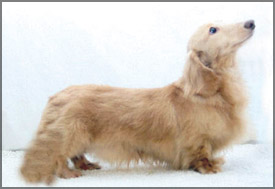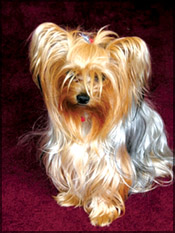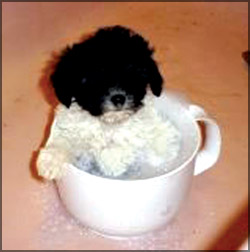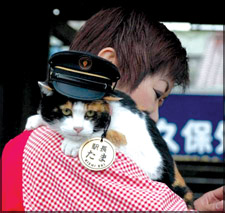|

Miniature dog breeds
|

Dachshund mix |
Have you ever seen miniature dogs? It may not be like having a huge
dog in your house, but itís really fun to have a miniature dog.
Do you know what exactly a miniature dog is? Miniature dog breeds are
defined as any breed of dog weighing less than 11 pounds and standing
less than 11 inches at the shoulder. There are many different breeds in
many different shapes and sizes.
|

Terrier |
The Affenpinscher, Beagle, Bichon Frise, Cavalier King Charles
Spaniel, Chihuahua, Dachshund, English Toy Spaniel, Havanese, Maltese,
Miniature Schnauzer, Pekingese, Pomeranian, Shih Tzu, Toy Poodle and
Yorkshire Terrier are just a few of these breeds.
Further, miniature dogs come with a variety of activity levels. Donít
be fooled that, just because a dog is small, its level of activity will
be low. While there are some lower energy small breeds such as the Pug,
many including the Australian Terrier, Beagle, Cairn Terrier, Italian
Greyhound, Miniature Pinscher and Wire Fox Terrier can display pretty
high energy. All miniature breeds will need some amount of exercise,
such as a walk with their owner or a romp around the yard. The care of a
miniature breed is pretty much like that of any other breed.
Long-haired breeds, whether miniature or large, will require regular
grooming, usually daily. Some miniature breeds with short coats may
require extra protection in cold weather and itís generally recommended
that smaller breeds not be kept in outdoor kennels. And just like any
other breed, miniature breeds should be fed a high-quality diet, though
nibbles may come in a smaller size.
Though many people believe that smaller breeds of dogs prove harder
to house-break, this isnít necessarily so; it depends on the individual
dog.
|

Poodle |
Small breeds are not prone to any more genetic disorders than other
breeds. However, their size tends to make them a favourite with
breeders, which can result in problems like inbreeding and poor
nutrition. Therefore, itís extra important that you acquire your
miniature breed through a reputable breeder.
You must also be committed to having and caring for your miniature
dog for quite some time as they generally live longer than larger
breeds. Small breeds may average between ten to twelve years of age,
though many can live much longer.
Small breeds are just as intelligent and energetic as larger breed
dogs and have similar personalities. In fact, they can even make good
watchdogs despite their diminutive (tiny) size. Further, youíre likely
to find that many small dogs arenít bothered by their smaller size and
have the personalities of much larger dogs.
The day I lost my Rossiy
Once I had a dog called Rossiy. She was my only pet; I never had
another pet.
Rossiy used to sleep near my bed. When I went to school, she would
walk with me upto the road. One day my pet fell ill. The next day I
didnít go to school, instead, I took Rossiy to the vet who said there
was nothing wrong with my pet and gave some tablets. I gave the tablets
to Rossiy until they were all gone, but still, she didnít get better.
I decided to take Rossiy to another doctor, who said she was
seriously ill. Then he also gave some tablets, which I, in turn, gave
Rossiy. Then I let her sleep for the night and went to sleep myself.
The next morning, I woke up and said ďGood MorningĒ to my darling
pet, but she wouldnít say anything. I spoke to her again, but when she
didnít respond, I realised that she was dead. Later, we dug a hole in
the ground and buried her there. I placed Rossiy on her pillow. That was
one of the saddest days of my life.
Gayan Daswatte, Grade 5, Ecole International,
Digana, Kandy.
Stationmaster cat
An eight-year-old cat called Tama has been named a special
stationmaster at a railway station in Japan by the local Wakayama
Electric Railway. Two other cats were named deputy stationmasters at the
same Kishi Station on the Kishigawa Line in Kinokawa. Stationmaster
Tama, wearing a railway cap, and the other cats often welcome passengers
at unmanned Kishi Station.
 The operator of the shop at the station has been keeping the three
cats. Wakayama Electric Railway officials will give cat food to them as
a reward for their "work." Tama won nationwide popularity with the
publication of a book of photos featuring her and intensive media
coverage after her appointment in 2007 as stationmaster. The operator of the shop at the station has been keeping the three
cats. Wakayama Electric Railway officials will give cat food to them as
a reward for their "work." Tama won nationwide popularity with the
publication of a book of photos featuring her and intensive media
coverage after her appointment in 2007 as stationmaster.
As a result, the number of passengers using the Kishigawa Line
increased dramatically. The railway company recognised the "efforts" of
the cat and promoted her to division chief-level in January.
The company also expressed its appreciation of the cat's role in
drumming up business by transforming a ticket window into the
stationmaster's office. In her 1.8-square-metre office equipped with a
ventilation fan and a toilet, Tama finds life rather relaxed and
satisfactory. |
